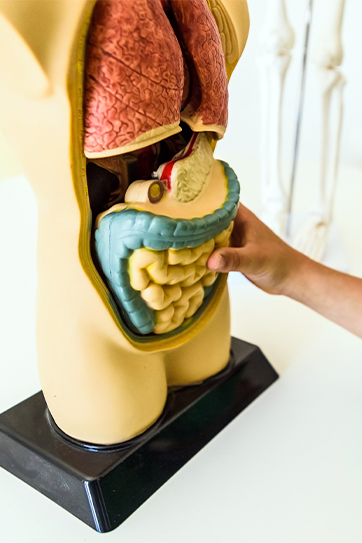Gallbladder cancer is a type of cancer that occurs as a result of abnormal growth and multiplication of cells in the gallbladder.
It is more commonly observed in adults and typically emerges after the age of 55. In Turkey, gallbladder cancer is a rare type of cancer, with approximately 1,500-2,000 people being diagnosed each year. It is more frequently diagnosed in women than in men, and early detection rates are low. The five-year survival rates are around 5-10%.
Globally, it is also a rare type of cancer, with approximately 200,000 people diagnosed each year. It is more prevalent in developed countries compared to developing ones, and early detection rates are higher in developed nations.
Gallbladder cancer may not exhibit clear symptoms in the early stages and is often recognized by symptoms that manifest as the disease progresses. The symptoms of gallbladder cancer may include:
The symptoms of gallbladder cancer typically become apparent in the advanced stages of the disease. Since it is challenging to diagnose in the early stages, it is important to consult a healthcare professional if such symptoms are noticed. Various imaging tests, blood tests, and biopsies can be employed to diagnose gallbladder cancer.
Several risk factors may contribute to the development of gallbladder cancer. These factors can vary depending on an individual's lifestyle, genetic predisposition, and various health conditions. The risk factors for gallbladder cancer include:
Having one or more of these factors may increase the risk of gallbladder cancer, but having these factors does not definitively mean a cancer diagnosis. It is important to consult a healthcare professional for any concerns or to gather more information about risk factors.
While preventing gallbladder cancer is challenging, the risk of developing cancer can be reduced through certain lifestyle changes and mitigating risk factors. Here are some recommendations to reduce the risk of gallbladder cancer:
While preventive measures can reduce the risk of gallbladder cancer, they do not eliminate it entirely. Consultation with a healthcare professional is essential for any concerns or to gather more information about risk factors.
The treatment of gallbladder cancer involves various methods determined by factors such as the patient's overall health, and the stage and type of cancer, among others. Surgical intervention (cholecystectomy) is a commonly used method in the treatment of gallbladder cancer. This procedure involves the complete removal of the gallbladder, and if necessary, surrounding tissues, lymph nodes, and segments of the liver can also be removed. The extent of the surgery may vary depending on the stage of the cancer.
Radiation therapy, using high-energy rays to target and kill cancer cells, is a treatment method employed in gallbladder cancer. It can be used before (neoadjuvant) or after (adjuvant) surgery. Radiation therapy can aid in reducing tumor size and minimizing the impact on surrounding tissues.
Chemotherapy, a drug treatment aiming to kill cancer cells or control their growth, is another method used in gallbladder cancer treatment. It can be applied before or after surgery, or in conjunction with radiation therapy. Chemotherapy has a systemic effect, targeting cancer cells throughout the body.
Targeted therapies aim to target specific characteristics of cancer cells. These treatments are often used in conjunction with other therapies and provide a more specific impact on cancer cells. Radioembolization involves injecting radioactive substances into the blood vessels that nourish the tumor, aiding in killing cancer cells and controlling tumor growth.
For detailed information about the gallbladder cancer treatment procedure, you can contact Medwide.




Get practical information about the topics you are most curious about. Everything you need to make informed decisions on your beauty and health journey is here with all the details from A to Z.
Yes, gallbladder cancer can typically be detected through imaging tests such as ultrasound. Ultrasound is a medical imaging technique that visualizes organs within the body using sound waves. Gallbladder cancer often presents as masses or tumors in the gallbladder, which can be detected through ultrasound. However, for a definitive diagnosis, additional imaging tests and methods such as biopsy may be necessary.
The life expectancy of bile duct cancer depends on numerous factors and can vary from person to person. The stage, type of cancer, treatment options, the patient's overall health, and response to treatment are among the factors that influence life expectancy. Unfortunately, bile duct cancers are often diagnosed in advanced stages, making early detection crucial for improved survival rates. While early diagnosis and effective treatment can increase life expectancy, this type of cancer tends to progress aggressively.
The removal of the gallbladder (cholecystectomy) is a common treatment option for conditions such as gallstones, inflammation, or cancer. While the gallbladder is an important organ for the body, its functions can be assimilated and taken over by other organs. Cholecystectomy typically does not shorten life, and individuals can lead a normal life after the removal of the gallbladder. Post-surgery, individuals may need to adhere to a specific diet and lifestyle changes, but these adjustments do not generally impact life expectancy. Consultation with a healthcare professional is advised for detailed information and recommendations.
Medwide meticulously arranges airport transfers for patients and their companions, ensuring their comfort and satisfaction.
Medwide's VIP transfer service offers patients a personalized and privileged travel experience, providing exceptional service.
Medwide transports patients and their companions comfortably and luxuriously, making their journeys enjoyable and relaxing.
Medwide offers quality healthcare services to patients at affordable prices, ensuring transparency and fairness in costs.
Medwide provides fast treatments by reducing patient wait times, our expert doctors promptly respond to our patients' needs.